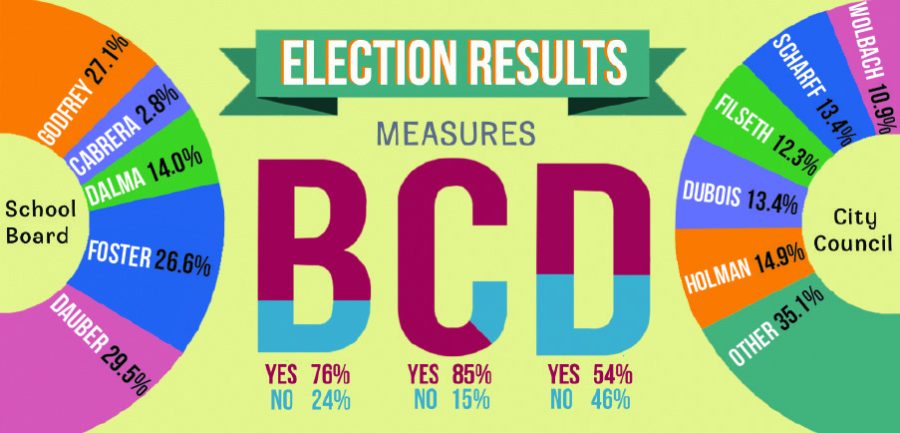Elections yield new visions for Palo Alto
Residents select City Council and school board representatives, vote on Measures B, C and D
On Nov. 4, Palo Alto residents voted in favor of anti-development candidates for city council, individuals with backgrounds in Palo Alto Unified School District (PAUSD) for school board and Measures B, C and D.
The 12 person candidate-pool for city council quickly became divided along the issue of future development in Palo Alto. Incumbent Karen Holman ran a campaign aligned with the anti-development “residentialist” group, while Greg Scharff ran with support from the established city council; they were both re-elected. Holman finished with more than 1,000 votes ahead of the other candidates. Scharff came in second place.
Residentialists Tom DuBois and Eric Filseth secured spots on the council early in the counting. Both were heavily involved in the opposition against new policies promoting development last year.
Lydia Kou, who worked with DuBois and Filseth against Measure D in the last election, was in a tight race against Cory Wolbach for the final spot on the council but ultimately lost, finishing 156 votes behind. Wolbach ran with the support from the “establishment,” current members on the council who have voted in the past for more growth.
Nancy Shepard and A.C. Johnston, who received endorsements from similar individuals to Wolbach and Scharff, finished sixth and seventh, respectively.
But following the clear anti-development vision favored by the majority of Palo Alto residents, current council members appointed two pro-urban revitalization techies, Kate Downing and Michael Alcheck, to the Planning and Transportation Commision on Nov. 10.
Residents also voted in favor of Measure D, which proposes to reduce the size of the city council from nine to seven in 2018, after minimal campaigning for either side. This was just placed on the ballot in a five to four vote within council members after years of prior talk.
The measure is meant to shorten meetings and lower costs, but opponents argue that it will further narrow the views of members and limit the size extensively when conflicts of interest arise.
In the school board election, Ken Dauber secured a spot in his third time running. After a close race between Terry Godfrey and Catherine Crystal Foster, with a gap closed to just 12 votes at one point in the counting, Godfrey claimed the second spot on the school board.
Throughout the campaign, it has become clear that all candidates share similar visions for the future of PAUSD: foreign language programs for elementary schools, use of data in decision-making and improvement of each student’s emotional health.
Voters approved two measures specific to Palo Alto. Measure B, which increases the transient occupancy tax, will raise visitors hotel tax from 12 percent to 14 percent. This revenue will go towards improving infrastructure — specifically earthquake safe fire stations and street and parking upgrades. The measure was passed easily with more than 75 percent of voters in favor.
Measure C updates the current utility tax to be more aligned with modern technology. It broadens the scope of the telecommunications tax rate while decreasing the rate from 5 percent to 4.75 percent so as to maintain equivalent revenue.
Voter turnout was lower than prior years at around 36 percent.
Your donation will support the student journalists of Palo Alto High School's newspaper



